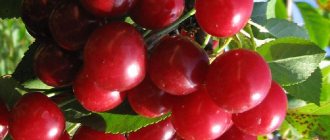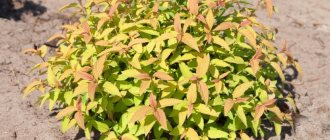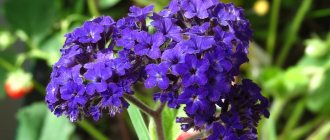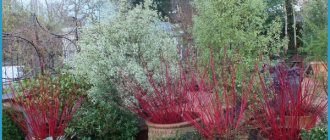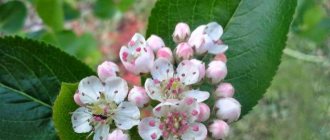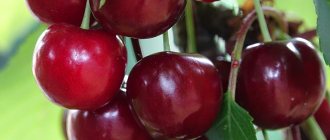Types and varieties of plants, appearance
The dogwood genus has approximately 50 species: it is often a deciduous tree or shrub, but there are also herbaceous and winter-green varieties. The most common is the common dogwood, known for its pear-shaped fruits of a deep red color (although they can be yellow, black, or purple).
The fruits of different varieties of plants also differ in taste: sweet, tart, sweet-tart, juicy, dry, etc.
The dogwood bush is a long-liver of the world of similar plants - it lives from 120 to 250 years.
Varietal diversity of the crop
Before you buy dogwood seedlings in a nursery, you need to know the main selection rule.
It is important! Dogwood is self-sterile; to obtain a harvest in the garden, you need to plant several pairs of bushes, preferably of different varieties.
The varietal diversity of this crop is not limited only to the names of the varieties and the type of plant, but also to the shape of the fruits - elliptical, pear-shaped, cylindrical, berries of purple, yellow, orange or pink hue.
The taste and aroma of this plant cannot be confused with any other. As for the popularity of varieties, the following are recognized as the highest priority in Moscow and the Moscow region:
- Vladimirsky - large fleshy fruits of a purple hue. They ripen in September, the yield per bush is up to 60 kg, some berries can reach a weight of 8 grams.
- Lukyanovsky - sweet and sour pear-shaped fruits of red color that ripen in the second ten days of September. Productivity per bush is up to 50 kilograms.
- Tender - yellow aromatic fruits with delicate pulp. The variety has an average yield - up to 40 kilograms per bush. The berries are not only tasty, but also beautiful; the seed is visible through the thin skin.
- Firefly is a variety with the largest burgundy berries. Fruits in August, great for freezing and canning.
- Elegant - an original variety with bottle-shaped cherry-colored fruits. Refers to early ripening varieties. You can taste the fruits at the end of July, and the crop yield is up to 50 kilograms per bush.
Where and how it grows, conditions
Wild and naturally cultivated dogwood can be found in Eastern and Southern Europe, the Caucasus, Asia Minor, China, Japan, and the American continents.
Dogwood usually grows in the form of a solitary tall shrub (from 3 to 8 meters). It is quite resistant to weather conditions, so it can live both in the mild climate of Crimea and in colder regions. The only thing that dogwood is really afraid of is sharp frosts that occur after a short-term warming in spring.
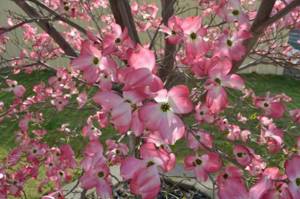
The plant is not picky about soil, but most of all it loves light, well-aerated soil. It is desirable that the acidity does not exceed 6 pH, and the groundwater is no closer than 1.5 meters. Feels good in open ground.
A dogwood planted from a seedling begins to bear fruit after 2-3 years. A sprouted seed will develop from 5 to 10 years until it bears fruit.
A brief excursion into the history of the emergence of culture
For a long time, dogwood was undeservedly ignored by gardeners. Meanwhile, this plant can grow in one place for about 200 years and spends most of its life span pampering its owners with a rich harvest of berries. The fruits of this tree are edible in their natural form, and are especially loved by housewives as preserves.
Popularly referred to as the “berry of Satan,” dogwood takes its ancestry from the times of Ancient Rome. It is generally accepted that it appeared from the spear of Romulus, stuck into the ground by the legendary founder of the city. Today, dogwood is distributed throughout the world; the plant can be found in the Caucasus and Moldova, in Russia and Europe, Asia and Ukraine.
Application
If you liked the dogwood plant, the berry (a photo of which will follow) will please you even more, because it has many beneficial properties known to our distant ancestors.
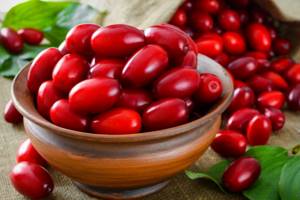
In medicine
Dogwood products are useful:
- against diarrhea due to the astringent tanidam;
- for diabetics, because they lower blood sugar levels;
- in case of lack of appetite, malfunction of the pancreas, vitamin deficiency;
- during hypertension, exacerbation of varicose veins.
In cooking
Not many people consume dogwood fruits in their raw form due to its specific taste and astringent properties. Products made from this berry are more popular: jam, jelly, jelly, wine. Astronauts are given dogwood products because of their high vitamin C content.
An original way to prepare a dogwood dish was invented in the Caucasus: the berries are ground through a sieve, the mass is made into flat cakes, and left to dry. It turns out something like pita bread! It is stored for up to 3 years, and the vitamins from it do not disappear anywhere.
Beneficial properties of dogwood berries
Dogwood has bactericidal, antipyretic and anti-inflammatory effects. The berries are used to treat anemia, hemorrhoids, typhoid, and gastrointestinal problems. The fruits also improve the metabolic process and remove uric and oxalic acids from the body. Thanks to the active substances contained in dogwood, it helps normalize blood pressure and eliminate headaches. Compotes and jams are made from dogwood berries, tinctures and sauces are made. By the way, dogwood jam is very tasty and unusually aromatic.
Harm and contraindications
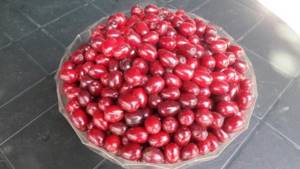
Dogwood, the photo of whose berries you will see below, has practically no contraindications, and there are no serious prohibitions (such as allergies) on its use at all.
However, it is not recommended to consume dogwood products for people with high acidity of gastric juice, suffering from insomnia, chronic constipation and excessive nervous excitability.
Diseases and pests
The berry plant has excellent immunity, as evidenced by its high resistance to diseases and pests. It is extremely rare, but it happens that the development of rust is noted on dogwood. The reason lies in the use of low-quality planting material. In infected dogwood, brown spots begin to appear gradually on the surface of the leaf blades. Bordeaux mixture will help fight the disease.
Dogwood is also occasionally affected by powdery mildew, which is treated with colloidal sulfur or an appropriate fungicidal preparation. The working fluid is prepared according to the instructions. Spots may be observed on the shoots. The already mentioned Bordeaux mixture helps. If a scale insect appears on the shoots, it is better to spray the bush with a broad-spectrum insecticide before the mass colonization begins. However, pesticides should be used before fruit formation begins.
It doesn't take superhuman effort to grow a healthy dogwood plant. The main thing is the desire and strict adherence to the agricultural technology of growing a representative of the family of the same name.
Nutritional value and chemical composition
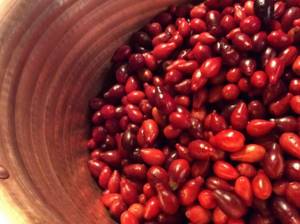
The value of dogwood fruits is great. Their pulp contains:
- essential oil, phytoncides, a lot of salts of magnesium, potassium, iron, calcium;
- in addition to the indicated vitamin C, vitamin P and provitamin A;
- about 3.5% organic acids: malic, citric, succinic;
- on average 13-15% sugar (fructose, glucose).
Calorie content – 40.5 kcal per 100 g.
When does the dogwood bloom?
Common dogwood blooms earlier than other fruit crops. As soon as the wintering onions emerged from the ground, currant and gooseberry buds began to bloom, the trees were still bare, and gardeners were delighted by the lush dogwood inflorescences. The flowers appear before the leaves and fall off as they begin to bloom.
Video: dogwood from bud break to harvest
The favorable temperature for flowering is 8–12 °C; in each region it is set at its own time. Thus, the average daily temperature of +10 °C in the Krasnodar region is observed in March, and in the Rostov region - in early April. In central Russia, dogwood blooms in mid-late April, and in the northern regions and Siberia - in late April - early May. Flowering lasts from one week to three, depending on the variety, and is almost always subject to return frosts. However, some species bloom in the summer and again in the fall, for example, White Dogwood.
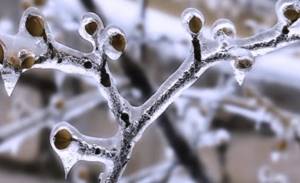
Large flower buds are formed already in August; in spring, flowers tolerate frosts down to -7 °C
How to grow, care, pests and diseases
Growing dogwood is not difficult, since the plant is very resistant to conditions, although the latter will affect its development and productivity.
The best time to plant dogwood is in the fall, when the poplar leaves begin to fall. The depth and diameter of the planting hole should be around 60 cm. Be sure to plant the dogwood at least 5 meters from the fence, preferably adding another bush at a distance of 3-5 m so that pollination can occur in the spring without the participation of bees.
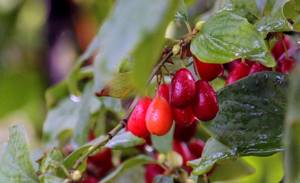
Caring for dogwood is limited to the first growing season. It is necessary to weed the space around the bush, loosen the soil to a depth of 10 cm, and provide drip irrigation and watering.
Dogwood, a photo of a shrub during cultivation you can find in the article, is also interesting because it practically does not suffer from various kinds of parasites and diseases. The fungus Ramularia angustifolia Sacc may cause brown edged spotting. The larvae of the dogwood warty sawfly and the dogwood sharp-winged moth can eat the leaves of the plant and leave their “mines” on them.
Short description
Dogwood, another name for male dogwood, belongs to the dogwood family. It includes frost-resistant ornamental shrubs and plants with fruits that are suitable for food.
In nature, it is found in Asia Minor, Southern and Eastern Europe, China, Japan and in the forests of the Caucasus. It grows as a small deciduous tree or shrub and can reach a height of 5-6 m.
The flowers are yellow, small, and formed in bunches. They bloom until green mass appears. The leaves are egg-shaped, up to 10 cm in size, shiny. Later, the fruits ripen - juicy drupes (berries with a seed inside) with a beautiful shell. The shape is usually elongated, they can grow up to 3 cm. Ripeness occurs in August-October.
Related article:
Trim strawberry leaves and tendrils
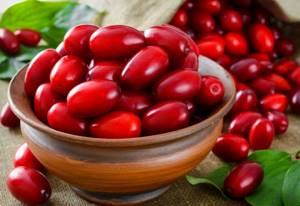
Decorative types of wood that are most often used for landscaping gardens or park areas:
- Aurea;
- Aurea Elegantissima;
- Variegata;
- Pyramidalis.
Preparation and storage
Despite the fact that the dogwood is almost the first to bloom among the trees, its fruit ripens almost the last. To prevent precious berries from being lost during frosts and subsequent cold spells, various dishes have been invented to quickly sell the product.
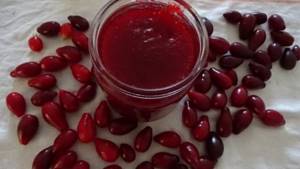
For dogwood compote you will need the fruits themselves, water and sugar. It will be enough to simmer the ingredients over low heat for 10 minutes, cool completely, and then heat again and roll into jars.
Dogwood jam is created without difficulty: the berries are rubbed through a sieve, sugar is added to them in a ratio of 1:1 or 1:1.5, all this is boiled for an hour and a half and packaged in jars.
Recommendations by region
When choosing a planting option, experienced gardeners advise be sure to take into account such important points as their zoning, ripening time and winter hardiness of the tree.
Krasnodar region
The growing season of the crop begins with the arrival of warmth in March, flowering ends by mid-April. The climatic conditions of the area allow both early and late varieties to be grown here. The most common:
- There was;
- Semyon;
- Amber.
Related article:
What we should not forget about after fruiting raspberries and currants
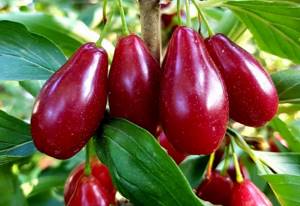
Using pruning, you can shape the plant to grow into a tree or shrub.
The main task of the gardener is to provide the dogwood with water during the hot or dry summer period.
Siberia
Applying traditional principles of agricultural technology, it is advisable to grow it with shrubs. Since the harsh winters of the region require additional shelter for the plant, in the fall its branches need to be tilted and fixed on the soil surface. Wrap it in snow, giving it the shape of a ball. Taking into account the peculiarities of the climate of Siberia, you can plant here:
- Coral;
- Joy.
Branches frozen in winter must be cut off in the spring, before sap begins to flow. When constant warm weather sets in, the plant quickly recovers, producing many root shoots.
Interesting! TOP 7 delicious and healthy northern berries, rich in vitamins
For the middle zone and Moscow region
Local summer residents, when growing crops, note freezing of shoots during the cold season. With the arrival of warmer weather, the bushes must be carefully inspected and damaged areas removed (cut off).
Plantings of the first 3-4 years must be covered with natural fabric or burlap for the winter. The area around the trunk of plants of any age must be mulched with humus or peat.
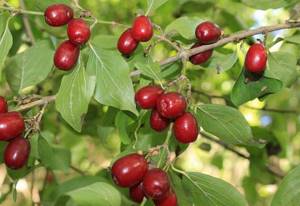
ofazende.ru
For regions with short summers, you should choose early varieties whose fruit ripeness occurs at the end of July to the first half of August. For example, for the Moscow region the following are suitable:
- Alyosha;
- Galitsky;
- Grenadier;
- Elena;
- Nikolka;
- Elegant.
Related article:
Cleaning the strawberry bed in autumn
Middle lane:
- Vladimirsky;
- Vydubitsky;
- Elena;
- Firefly.
The Volgograd derain also performed well, its productivity can reach up to 20 kg per tree.
For the south of Russia
The climate of the Rostov region allows the cultivation of dogwood without the need for additional shelter. Popular types are:
- Vladimirsky;
- Vydubitsky.
In the south of the country, you can give preference to such options as:
- Coral;
- Lukyanovsky;
- Gentle;
- Amber.
